Consumer Behaviour and Insights: Decision Making Process Report
VerifiedAdded on 2020/06/06
|10
|2759
|461
Report
AI Summary
This report examines consumer behavior and insights, focusing on the consumer decision-making process. It begins by outlining the five stages of the consumer decision-making journey: need recognition, information search, evaluation of alternatives, purchase decision, and post-purchase evaluation, using Thomas Food Centre as a case study. The report emphasizes the significance of understanding consumer behavior for marketers, particularly in mapping a path to purchase and formulating effective marketing strategies. It then differentiates between B2C and B2B decision-making processes, highlighting key differences such as the customer type, buying cycle length, and brand value creation. The report also explores various market research approaches and methods used to understand consumer decision-making, including primary and secondary data collection, and qualitative and quantitative research methods. Finally, the report discusses how marketers can influence each stage of the decision-making process in both B2C and B2B contexts, emphasizing the importance of adapting to the changing needs and requirements of consumers.
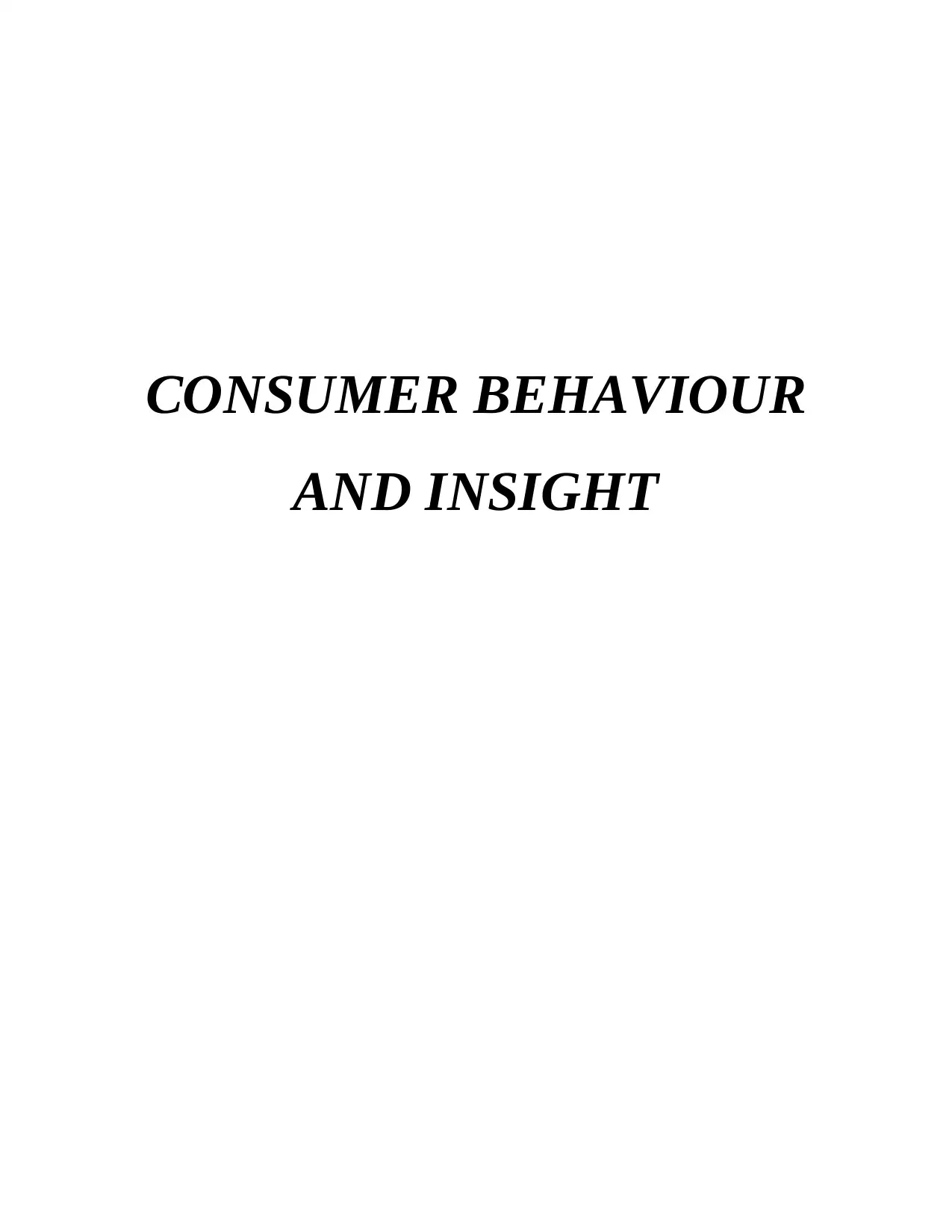
CONSUMER BEHAVIOUR
AND INSIGHT
AND INSIGHT
Paraphrase This Document
Need a fresh take? Get an instant paraphrase of this document with our AI Paraphraser
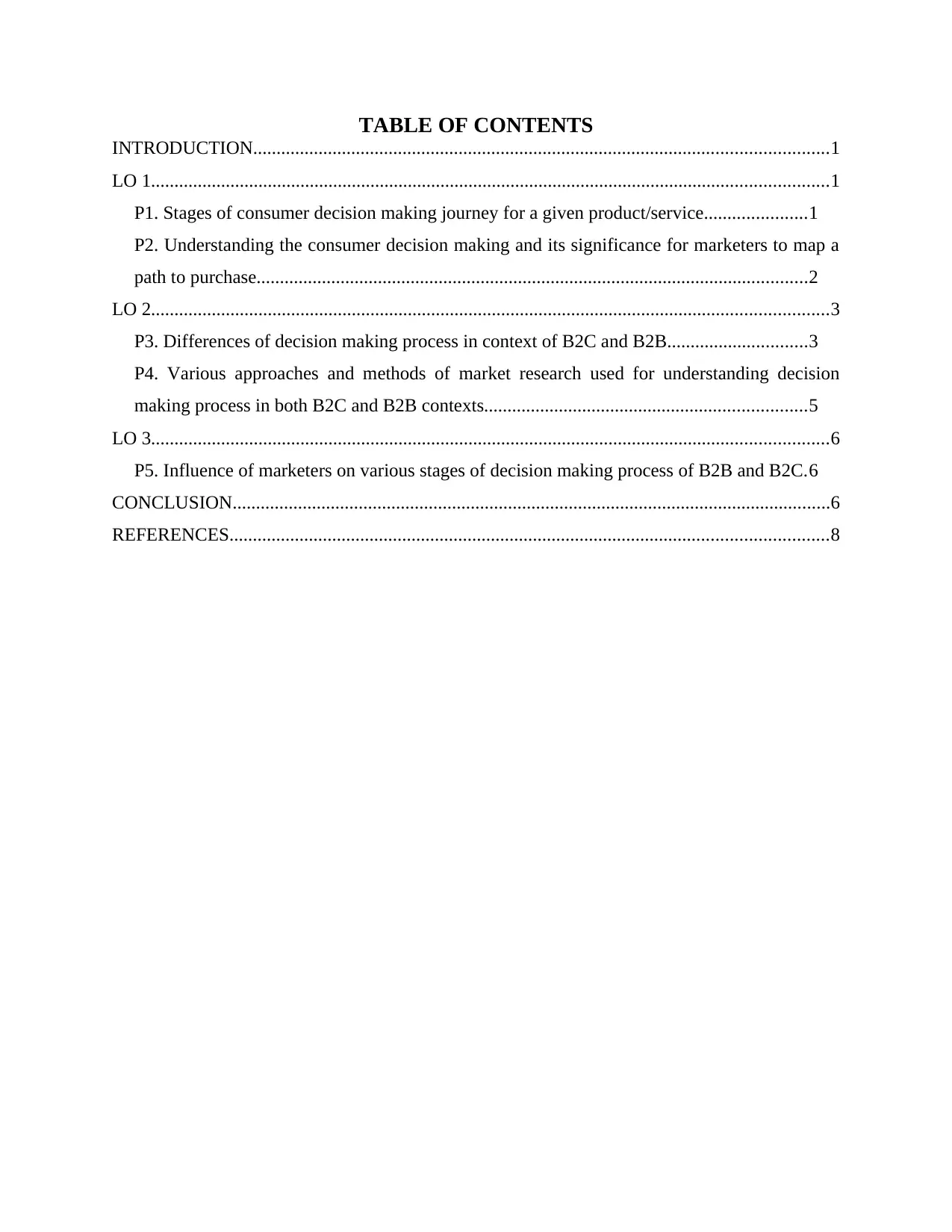
TABLE OF CONTENTS
INTRODUCTION...........................................................................................................................1
LO 1.................................................................................................................................................1
P1. Stages of consumer decision making journey for a given product/service......................1
P2. Understanding the consumer decision making and its significance for marketers to map a
path to purchase......................................................................................................................2
LO 2.................................................................................................................................................3
P3. Differences of decision making process in context of B2C and B2B..............................3
P4. Various approaches and methods of market research used for understanding decision
making process in both B2C and B2B contexts.....................................................................5
LO 3.................................................................................................................................................6
P5. Influence of marketers on various stages of decision making process of B2B and B2C.6
CONCLUSION................................................................................................................................6
REFERENCES................................................................................................................................8
INTRODUCTION...........................................................................................................................1
LO 1.................................................................................................................................................1
P1. Stages of consumer decision making journey for a given product/service......................1
P2. Understanding the consumer decision making and its significance for marketers to map a
path to purchase......................................................................................................................2
LO 2.................................................................................................................................................3
P3. Differences of decision making process in context of B2C and B2B..............................3
P4. Various approaches and methods of market research used for understanding decision
making process in both B2C and B2B contexts.....................................................................5
LO 3.................................................................................................................................................6
P5. Influence of marketers on various stages of decision making process of B2B and B2C.6
CONCLUSION................................................................................................................................6
REFERENCES................................................................................................................................8
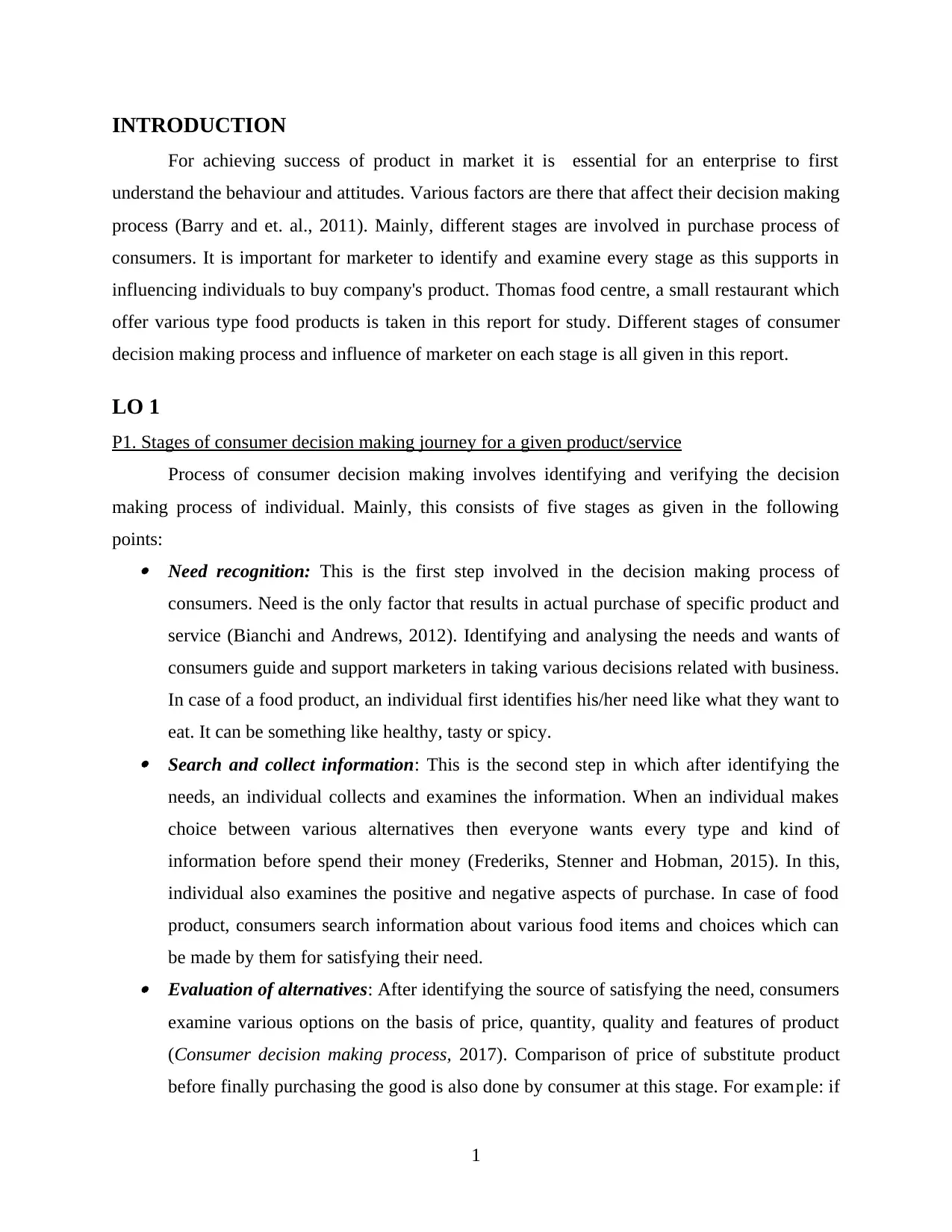
INTRODUCTION
For achieving success of product in market it is essential for an enterprise to first
understand the behaviour and attitudes. Various factors are there that affect their decision making
process (Barry and et. al., 2011). Mainly, different stages are involved in purchase process of
consumers. It is important for marketer to identify and examine every stage as this supports in
influencing individuals to buy company's product. Thomas food centre, a small restaurant which
offer various type food products is taken in this report for study. Different stages of consumer
decision making process and influence of marketer on each stage is all given in this report.
LO 1
P1. Stages of consumer decision making journey for a given product/service
Process of consumer decision making involves identifying and verifying the decision
making process of individual. Mainly, this consists of five stages as given in the following
points: Need recognition: This is the first step involved in the decision making process of
consumers. Need is the only factor that results in actual purchase of specific product and
service (Bianchi and Andrews, 2012). Identifying and analysing the needs and wants of
consumers guide and support marketers in taking various decisions related with business.
In case of a food product, an individual first identifies his/her need like what they want to
eat. It can be something like healthy, tasty or spicy. Search and collect information: This is the second step in which after identifying the
needs, an individual collects and examines the information. When an individual makes
choice between various alternatives then everyone wants every type and kind of
information before spend their money (Frederiks, Stenner and Hobman, 2015). In this,
individual also examines the positive and negative aspects of purchase. In case of food
product, consumers search information about various food items and choices which can
be made by them for satisfying their need. Evaluation of alternatives: After identifying the source of satisfying the need, consumers
examine various options on the basis of price, quantity, quality and features of product
(Consumer decision making process, 2017). Comparison of price of substitute product
before finally purchasing the good is also done by consumer at this stage. For example: if
1
For achieving success of product in market it is essential for an enterprise to first
understand the behaviour and attitudes. Various factors are there that affect their decision making
process (Barry and et. al., 2011). Mainly, different stages are involved in purchase process of
consumers. It is important for marketer to identify and examine every stage as this supports in
influencing individuals to buy company's product. Thomas food centre, a small restaurant which
offer various type food products is taken in this report for study. Different stages of consumer
decision making process and influence of marketer on each stage is all given in this report.
LO 1
P1. Stages of consumer decision making journey for a given product/service
Process of consumer decision making involves identifying and verifying the decision
making process of individual. Mainly, this consists of five stages as given in the following
points: Need recognition: This is the first step involved in the decision making process of
consumers. Need is the only factor that results in actual purchase of specific product and
service (Bianchi and Andrews, 2012). Identifying and analysing the needs and wants of
consumers guide and support marketers in taking various decisions related with business.
In case of a food product, an individual first identifies his/her need like what they want to
eat. It can be something like healthy, tasty or spicy. Search and collect information: This is the second step in which after identifying the
needs, an individual collects and examines the information. When an individual makes
choice between various alternatives then everyone wants every type and kind of
information before spend their money (Frederiks, Stenner and Hobman, 2015). In this,
individual also examines the positive and negative aspects of purchase. In case of food
product, consumers search information about various food items and choices which can
be made by them for satisfying their need. Evaluation of alternatives: After identifying the source of satisfying the need, consumers
examine various options on the basis of price, quantity, quality and features of product
(Consumer decision making process, 2017). Comparison of price of substitute product
before finally purchasing the good is also done by consumer at this stage. For example: if
1
⊘ This is a preview!⊘
Do you want full access?
Subscribe today to unlock all pages.

Trusted by 1+ million students worldwide
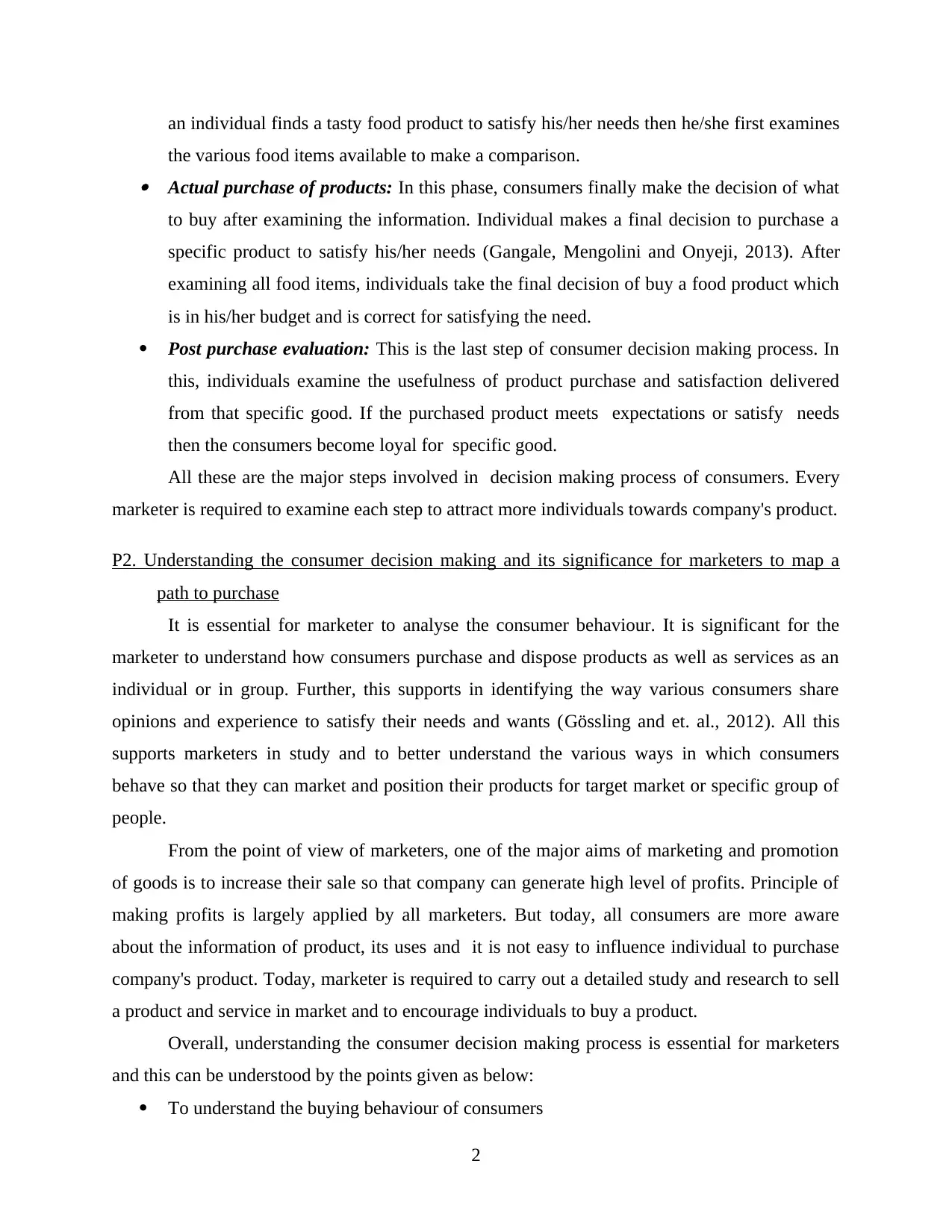
an individual finds a tasty food product to satisfy his/her needs then he/she first examines
the various food items available to make a comparison. Actual purchase of products: In this phase, consumers finally make the decision of what
to buy after examining the information. Individual makes a final decision to purchase a
specific product to satisfy his/her needs (Gangale, Mengolini and Onyeji, 2013). After
examining all food items, individuals take the final decision of buy a food product which
is in his/her budget and is correct for satisfying the need.
Post purchase evaluation: This is the last step of consumer decision making process. In
this, individuals examine the usefulness of product purchase and satisfaction delivered
from that specific good. If the purchased product meets expectations or satisfy needs
then the consumers become loyal for specific good.
All these are the major steps involved in decision making process of consumers. Every
marketer is required to examine each step to attract more individuals towards company's product.
P2. Understanding the consumer decision making and its significance for marketers to map a
path to purchase
It is essential for marketer to analyse the consumer behaviour. It is significant for the
marketer to understand how consumers purchase and dispose products as well as services as an
individual or in group. Further, this supports in identifying the way various consumers share
opinions and experience to satisfy their needs and wants (Gössling and et. al., 2012). All this
supports marketers in study and to better understand the various ways in which consumers
behave so that they can market and position their products for target market or specific group of
people.
From the point of view of marketers, one of the major aims of marketing and promotion
of goods is to increase their sale so that company can generate high level of profits. Principle of
making profits is largely applied by all marketers. But today, all consumers are more aware
about the information of product, its uses and it is not easy to influence individual to purchase
company's product. Today, marketer is required to carry out a detailed study and research to sell
a product and service in market and to encourage individuals to buy a product.
Overall, understanding the consumer decision making process is essential for marketers
and this can be understood by the points given as below:
To understand the buying behaviour of consumers
2
the various food items available to make a comparison. Actual purchase of products: In this phase, consumers finally make the decision of what
to buy after examining the information. Individual makes a final decision to purchase a
specific product to satisfy his/her needs (Gangale, Mengolini and Onyeji, 2013). After
examining all food items, individuals take the final decision of buy a food product which
is in his/her budget and is correct for satisfying the need.
Post purchase evaluation: This is the last step of consumer decision making process. In
this, individuals examine the usefulness of product purchase and satisfaction delivered
from that specific good. If the purchased product meets expectations or satisfy needs
then the consumers become loyal for specific good.
All these are the major steps involved in decision making process of consumers. Every
marketer is required to examine each step to attract more individuals towards company's product.
P2. Understanding the consumer decision making and its significance for marketers to map a
path to purchase
It is essential for marketer to analyse the consumer behaviour. It is significant for the
marketer to understand how consumers purchase and dispose products as well as services as an
individual or in group. Further, this supports in identifying the way various consumers share
opinions and experience to satisfy their needs and wants (Gössling and et. al., 2012). All this
supports marketers in study and to better understand the various ways in which consumers
behave so that they can market and position their products for target market or specific group of
people.
From the point of view of marketers, one of the major aims of marketing and promotion
of goods is to increase their sale so that company can generate high level of profits. Principle of
making profits is largely applied by all marketers. But today, all consumers are more aware
about the information of product, its uses and it is not easy to influence individual to purchase
company's product. Today, marketer is required to carry out a detailed study and research to sell
a product and service in market and to encourage individuals to buy a product.
Overall, understanding the consumer decision making process is essential for marketers
and this can be understood by the points given as below:
To understand the buying behaviour of consumers
2
Paraphrase This Document
Need a fresh take? Get an instant paraphrase of this document with our AI Paraphraser
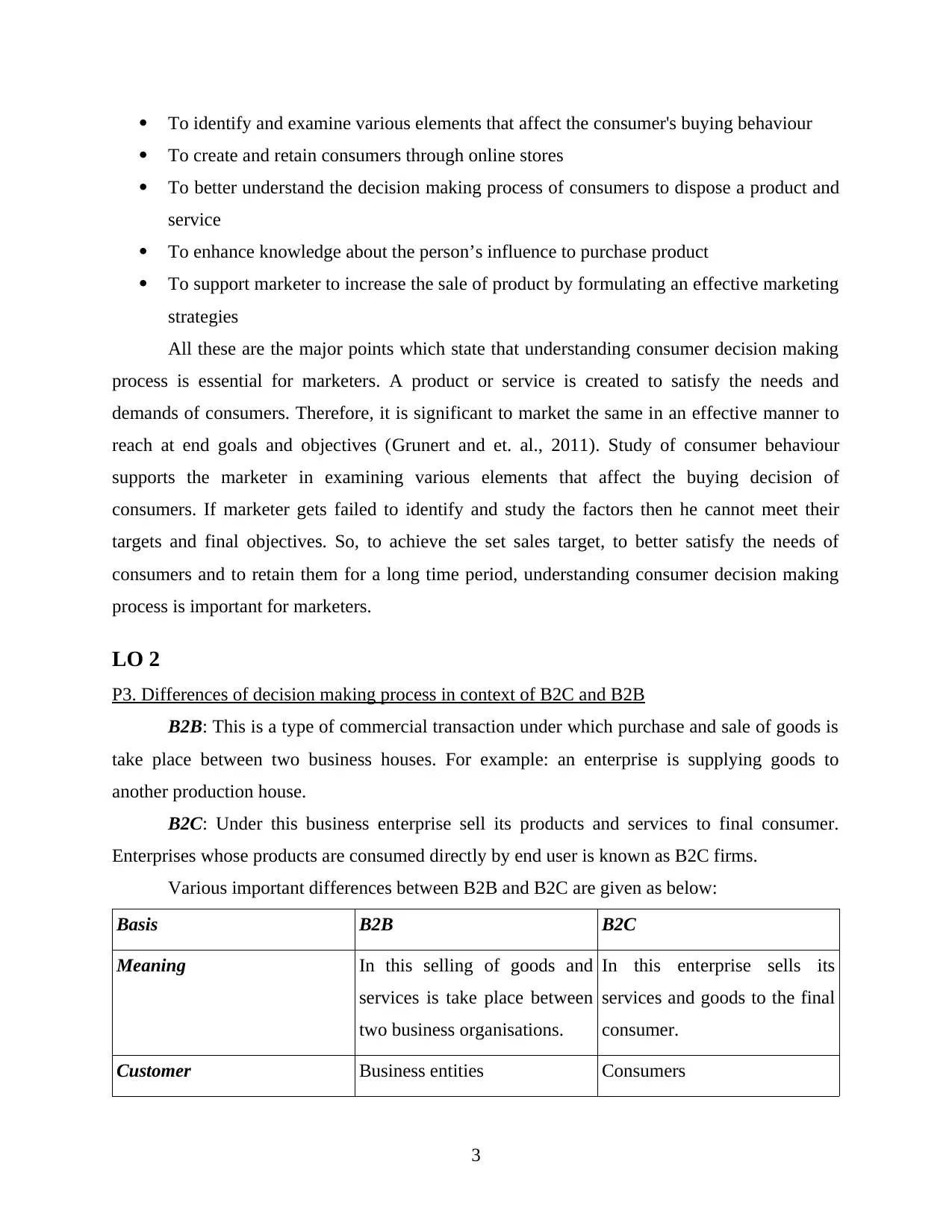
To identify and examine various elements that affect the consumer's buying behaviour
To create and retain consumers through online stores
To better understand the decision making process of consumers to dispose a product and
service
To enhance knowledge about the person’s influence to purchase product
To support marketer to increase the sale of product by formulating an effective marketing
strategies
All these are the major points which state that understanding consumer decision making
process is essential for marketers. A product or service is created to satisfy the needs and
demands of consumers. Therefore, it is significant to market the same in an effective manner to
reach at end goals and objectives (Grunert and et. al., 2011). Study of consumer behaviour
supports the marketer in examining various elements that affect the buying decision of
consumers. If marketer gets failed to identify and study the factors then he cannot meet their
targets and final objectives. So, to achieve the set sales target, to better satisfy the needs of
consumers and to retain them for a long time period, understanding consumer decision making
process is important for marketers.
LO 2
P3. Differences of decision making process in context of B2C and B2B
B2B: This is a type of commercial transaction under which purchase and sale of goods is
take place between two business houses. For example: an enterprise is supplying goods to
another production house.
B2C: Under this business enterprise sell its products and services to final consumer.
Enterprises whose products are consumed directly by end user is known as B2C firms.
Various important differences between B2B and B2C are given as below:
Basis B2B B2C
Meaning In this selling of goods and
services is take place between
two business organisations.
In this enterprise sells its
services and goods to the final
consumer.
Customer Business entities Consumers
3
To create and retain consumers through online stores
To better understand the decision making process of consumers to dispose a product and
service
To enhance knowledge about the person’s influence to purchase product
To support marketer to increase the sale of product by formulating an effective marketing
strategies
All these are the major points which state that understanding consumer decision making
process is essential for marketers. A product or service is created to satisfy the needs and
demands of consumers. Therefore, it is significant to market the same in an effective manner to
reach at end goals and objectives (Grunert and et. al., 2011). Study of consumer behaviour
supports the marketer in examining various elements that affect the buying decision of
consumers. If marketer gets failed to identify and study the factors then he cannot meet their
targets and final objectives. So, to achieve the set sales target, to better satisfy the needs of
consumers and to retain them for a long time period, understanding consumer decision making
process is important for marketers.
LO 2
P3. Differences of decision making process in context of B2C and B2B
B2B: This is a type of commercial transaction under which purchase and sale of goods is
take place between two business houses. For example: an enterprise is supplying goods to
another production house.
B2C: Under this business enterprise sell its products and services to final consumer.
Enterprises whose products are consumed directly by end user is known as B2C firms.
Various important differences between B2B and B2C are given as below:
Basis B2B B2C
Meaning In this selling of goods and
services is take place between
two business organisations.
In this enterprise sells its
services and goods to the final
consumer.
Customer Business entities Consumers
3
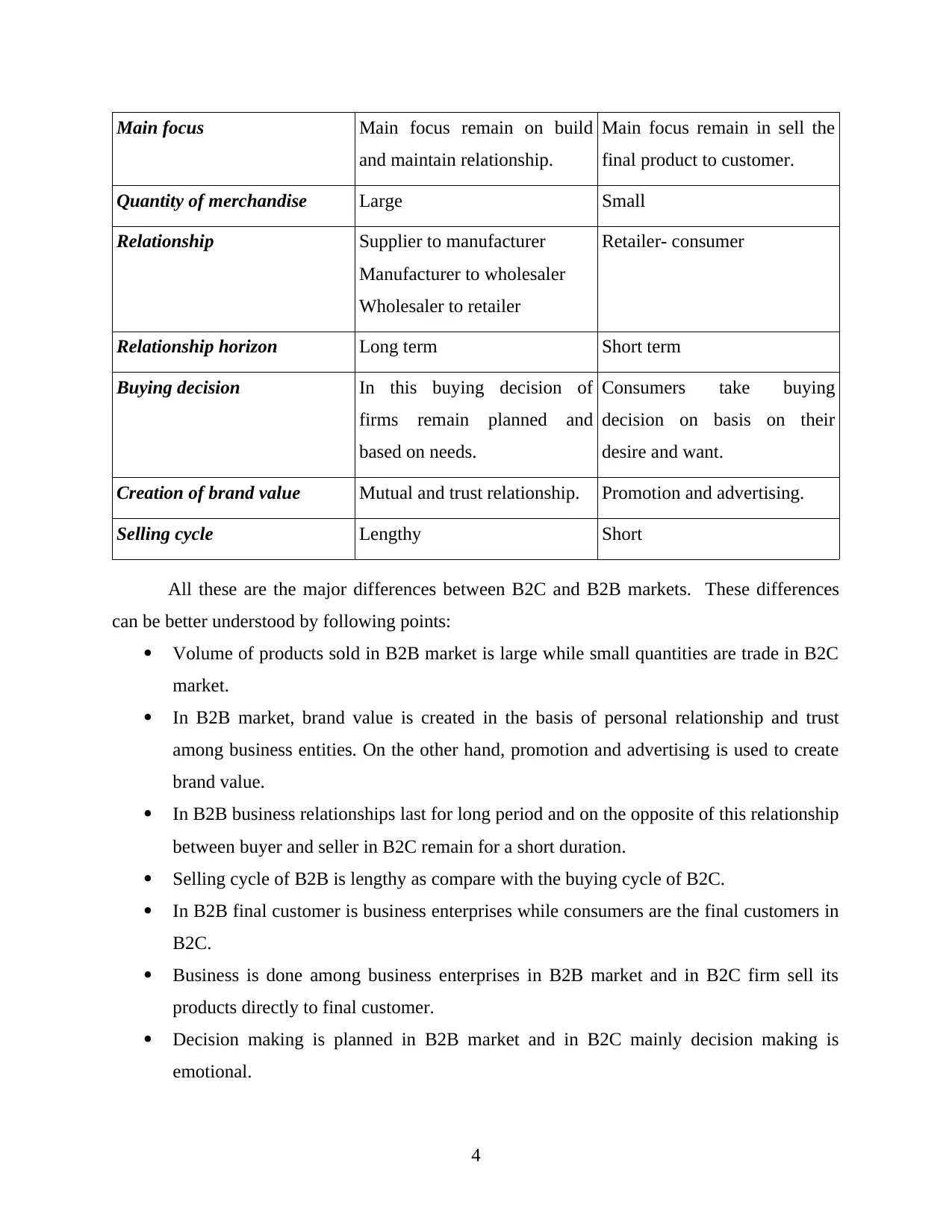
Main focus Main focus remain on build
and maintain relationship.
Main focus remain in sell the
final product to customer.
Quantity of merchandise Large Small
Relationship Supplier to manufacturer
Manufacturer to wholesaler
Wholesaler to retailer
Retailer- consumer
Relationship horizon Long term Short term
Buying decision In this buying decision of
firms remain planned and
based on needs.
Consumers take buying
decision on basis on their
desire and want.
Creation of brand value Mutual and trust relationship. Promotion and advertising.
Selling cycle Lengthy Short
All these are the major differences between B2C and B2B markets. These differences
can be better understood by following points:
Volume of products sold in B2B market is large while small quantities are trade in B2C
market.
In B2B market, brand value is created in the basis of personal relationship and trust
among business entities. On the other hand, promotion and advertising is used to create
brand value.
In B2B business relationships last for long period and on the opposite of this relationship
between buyer and seller in B2C remain for a short duration.
Selling cycle of B2B is lengthy as compare with the buying cycle of B2C.
In B2B final customer is business enterprises while consumers are the final customers in
B2C.
Business is done among business enterprises in B2B market and in B2C firm sell its
products directly to final customer.
Decision making is planned in B2B market and in B2C mainly decision making is
emotional.
4
and maintain relationship.
Main focus remain in sell the
final product to customer.
Quantity of merchandise Large Small
Relationship Supplier to manufacturer
Manufacturer to wholesaler
Wholesaler to retailer
Retailer- consumer
Relationship horizon Long term Short term
Buying decision In this buying decision of
firms remain planned and
based on needs.
Consumers take buying
decision on basis on their
desire and want.
Creation of brand value Mutual and trust relationship. Promotion and advertising.
Selling cycle Lengthy Short
All these are the major differences between B2C and B2B markets. These differences
can be better understood by following points:
Volume of products sold in B2B market is large while small quantities are trade in B2C
market.
In B2B market, brand value is created in the basis of personal relationship and trust
among business entities. On the other hand, promotion and advertising is used to create
brand value.
In B2B business relationships last for long period and on the opposite of this relationship
between buyer and seller in B2C remain for a short duration.
Selling cycle of B2B is lengthy as compare with the buying cycle of B2C.
In B2B final customer is business enterprises while consumers are the final customers in
B2C.
Business is done among business enterprises in B2B market and in B2C firm sell its
products directly to final customer.
Decision making is planned in B2B market and in B2C mainly decision making is
emotional.
4
⊘ This is a preview!⊘
Do you want full access?
Subscribe today to unlock all pages.

Trusted by 1+ million students worldwide
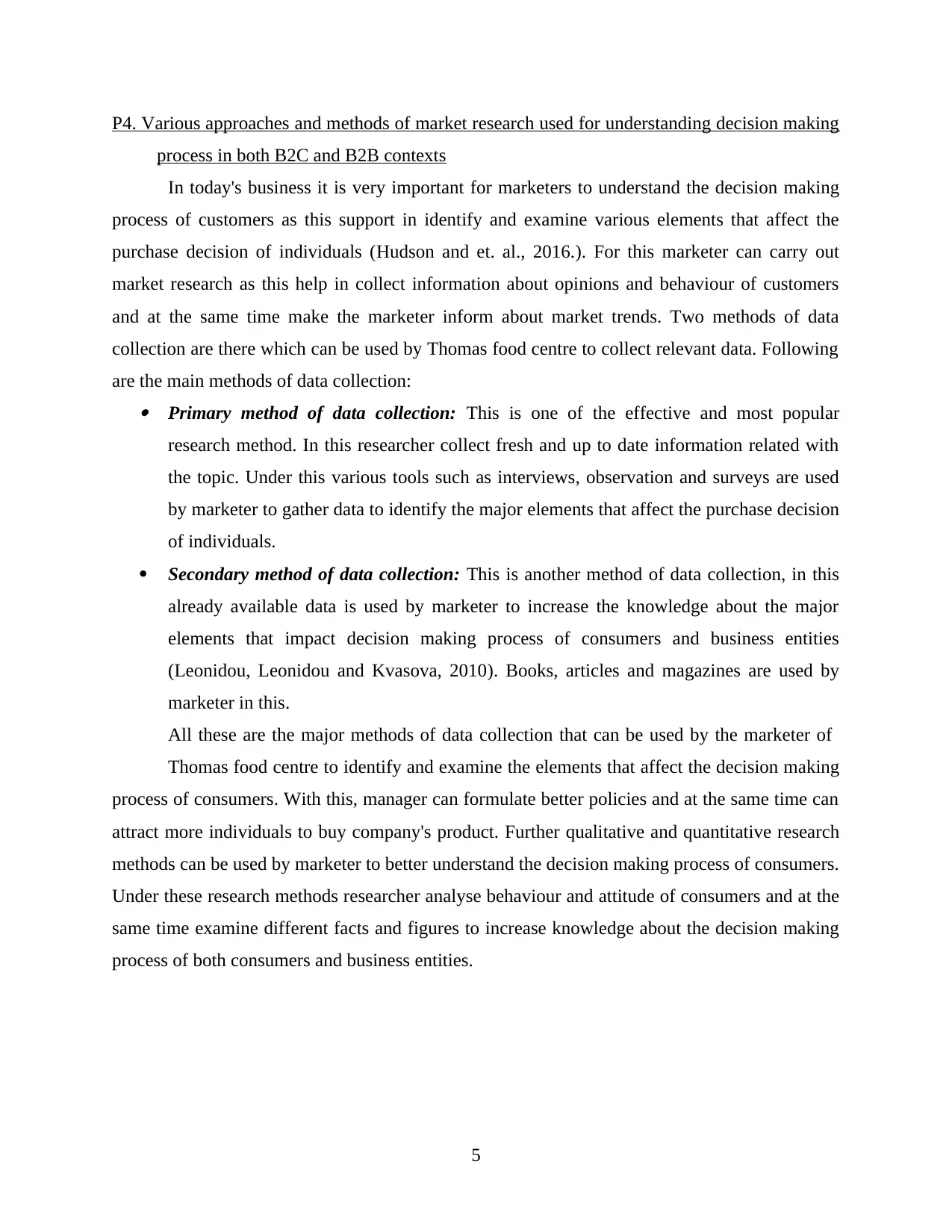
P4. Various approaches and methods of market research used for understanding decision making
process in both B2C and B2B contexts
In today's business it is very important for marketers to understand the decision making
process of customers as this support in identify and examine various elements that affect the
purchase decision of individuals (Hudson and et. al., 2016.). For this marketer can carry out
market research as this help in collect information about opinions and behaviour of customers
and at the same time make the marketer inform about market trends. Two methods of data
collection are there which can be used by Thomas food centre to collect relevant data. Following
are the main methods of data collection: Primary method of data collection: This is one of the effective and most popular
research method. In this researcher collect fresh and up to date information related with
the topic. Under this various tools such as interviews, observation and surveys are used
by marketer to gather data to identify the major elements that affect the purchase decision
of individuals.
Secondary method of data collection: This is another method of data collection, in this
already available data is used by marketer to increase the knowledge about the major
elements that impact decision making process of consumers and business entities
(Leonidou, Leonidou and Kvasova, 2010). Books, articles and magazines are used by
marketer in this.
All these are the major methods of data collection that can be used by the marketer of
Thomas food centre to identify and examine the elements that affect the decision making
process of consumers. With this, manager can formulate better policies and at the same time can
attract more individuals to buy company's product. Further qualitative and quantitative research
methods can be used by marketer to better understand the decision making process of consumers.
Under these research methods researcher analyse behaviour and attitude of consumers and at the
same time examine different facts and figures to increase knowledge about the decision making
process of both consumers and business entities.
5
process in both B2C and B2B contexts
In today's business it is very important for marketers to understand the decision making
process of customers as this support in identify and examine various elements that affect the
purchase decision of individuals (Hudson and et. al., 2016.). For this marketer can carry out
market research as this help in collect information about opinions and behaviour of customers
and at the same time make the marketer inform about market trends. Two methods of data
collection are there which can be used by Thomas food centre to collect relevant data. Following
are the main methods of data collection: Primary method of data collection: This is one of the effective and most popular
research method. In this researcher collect fresh and up to date information related with
the topic. Under this various tools such as interviews, observation and surveys are used
by marketer to gather data to identify the major elements that affect the purchase decision
of individuals.
Secondary method of data collection: This is another method of data collection, in this
already available data is used by marketer to increase the knowledge about the major
elements that impact decision making process of consumers and business entities
(Leonidou, Leonidou and Kvasova, 2010). Books, articles and magazines are used by
marketer in this.
All these are the major methods of data collection that can be used by the marketer of
Thomas food centre to identify and examine the elements that affect the decision making
process of consumers. With this, manager can formulate better policies and at the same time can
attract more individuals to buy company's product. Further qualitative and quantitative research
methods can be used by marketer to better understand the decision making process of consumers.
Under these research methods researcher analyse behaviour and attitude of consumers and at the
same time examine different facts and figures to increase knowledge about the decision making
process of both consumers and business entities.
5
Paraphrase This Document
Need a fresh take? Get an instant paraphrase of this document with our AI Paraphraser
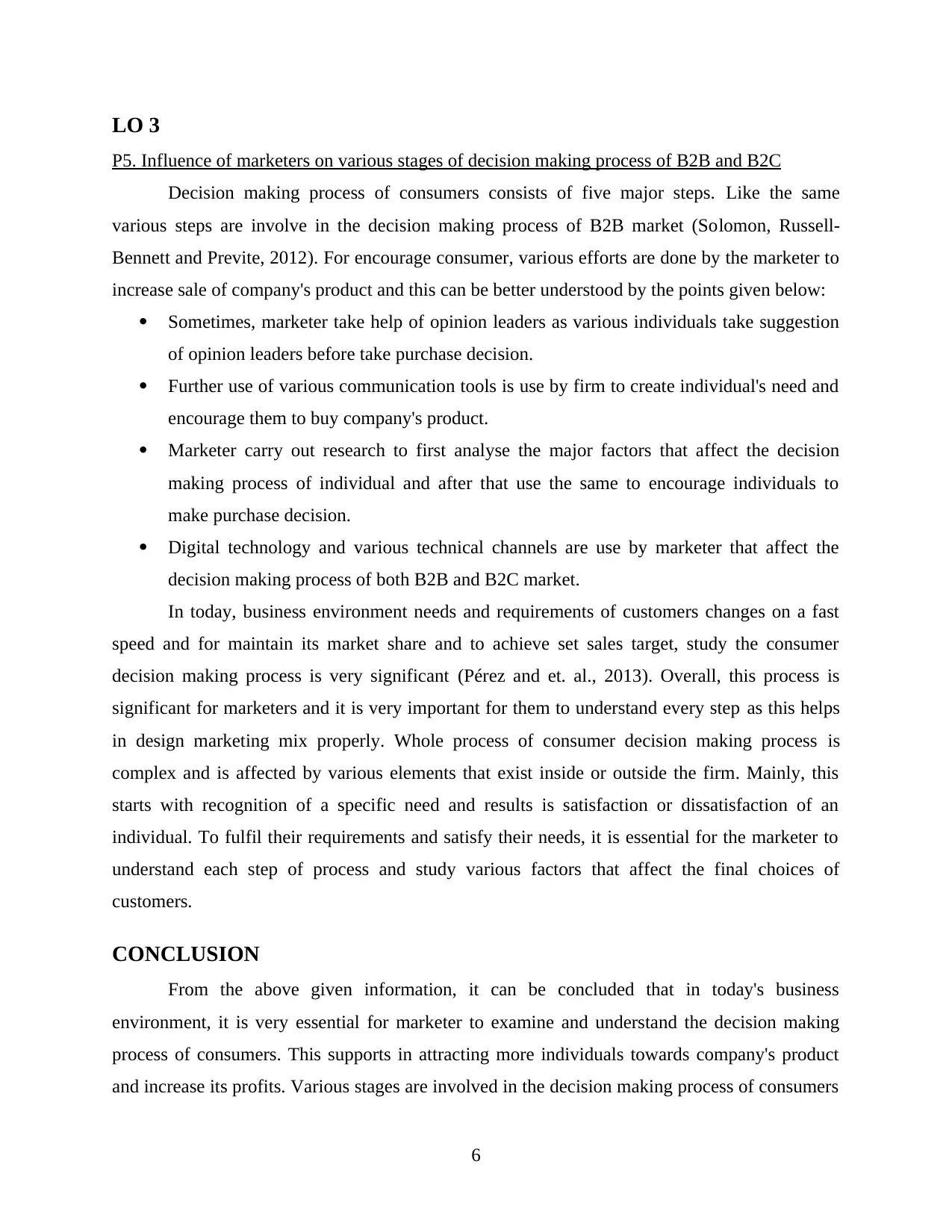
LO 3
P5. Influence of marketers on various stages of decision making process of B2B and B2C
Decision making process of consumers consists of five major steps. Like the same
various steps are involve in the decision making process of B2B market (Solomon, Russell-
Bennett and Previte, 2012). For encourage consumer, various efforts are done by the marketer to
increase sale of company's product and this can be better understood by the points given below:
Sometimes, marketer take help of opinion leaders as various individuals take suggestion
of opinion leaders before take purchase decision.
Further use of various communication tools is use by firm to create individual's need and
encourage them to buy company's product.
Marketer carry out research to first analyse the major factors that affect the decision
making process of individual and after that use the same to encourage individuals to
make purchase decision.
Digital technology and various technical channels are use by marketer that affect the
decision making process of both B2B and B2C market.
In today, business environment needs and requirements of customers changes on a fast
speed and for maintain its market share and to achieve set sales target, study the consumer
decision making process is very significant (Pérez and et. al., 2013). Overall, this process is
significant for marketers and it is very important for them to understand every step as this helps
in design marketing mix properly. Whole process of consumer decision making process is
complex and is affected by various elements that exist inside or outside the firm. Mainly, this
starts with recognition of a specific need and results is satisfaction or dissatisfaction of an
individual. To fulfil their requirements and satisfy their needs, it is essential for the marketer to
understand each step of process and study various factors that affect the final choices of
customers.
CONCLUSION
From the above given information, it can be concluded that in today's business
environment, it is very essential for marketer to examine and understand the decision making
process of consumers. This supports in attracting more individuals towards company's product
and increase its profits. Various stages are involved in the decision making process of consumers
6
P5. Influence of marketers on various stages of decision making process of B2B and B2C
Decision making process of consumers consists of five major steps. Like the same
various steps are involve in the decision making process of B2B market (Solomon, Russell-
Bennett and Previte, 2012). For encourage consumer, various efforts are done by the marketer to
increase sale of company's product and this can be better understood by the points given below:
Sometimes, marketer take help of opinion leaders as various individuals take suggestion
of opinion leaders before take purchase decision.
Further use of various communication tools is use by firm to create individual's need and
encourage them to buy company's product.
Marketer carry out research to first analyse the major factors that affect the decision
making process of individual and after that use the same to encourage individuals to
make purchase decision.
Digital technology and various technical channels are use by marketer that affect the
decision making process of both B2B and B2C market.
In today, business environment needs and requirements of customers changes on a fast
speed and for maintain its market share and to achieve set sales target, study the consumer
decision making process is very significant (Pérez and et. al., 2013). Overall, this process is
significant for marketers and it is very important for them to understand every step as this helps
in design marketing mix properly. Whole process of consumer decision making process is
complex and is affected by various elements that exist inside or outside the firm. Mainly, this
starts with recognition of a specific need and results is satisfaction or dissatisfaction of an
individual. To fulfil their requirements and satisfy their needs, it is essential for the marketer to
understand each step of process and study various factors that affect the final choices of
customers.
CONCLUSION
From the above given information, it can be concluded that in today's business
environment, it is very essential for marketer to examine and understand the decision making
process of consumers. This supports in attracting more individuals towards company's product
and increase its profits. Various stages are involved in the decision making process of consumers
6
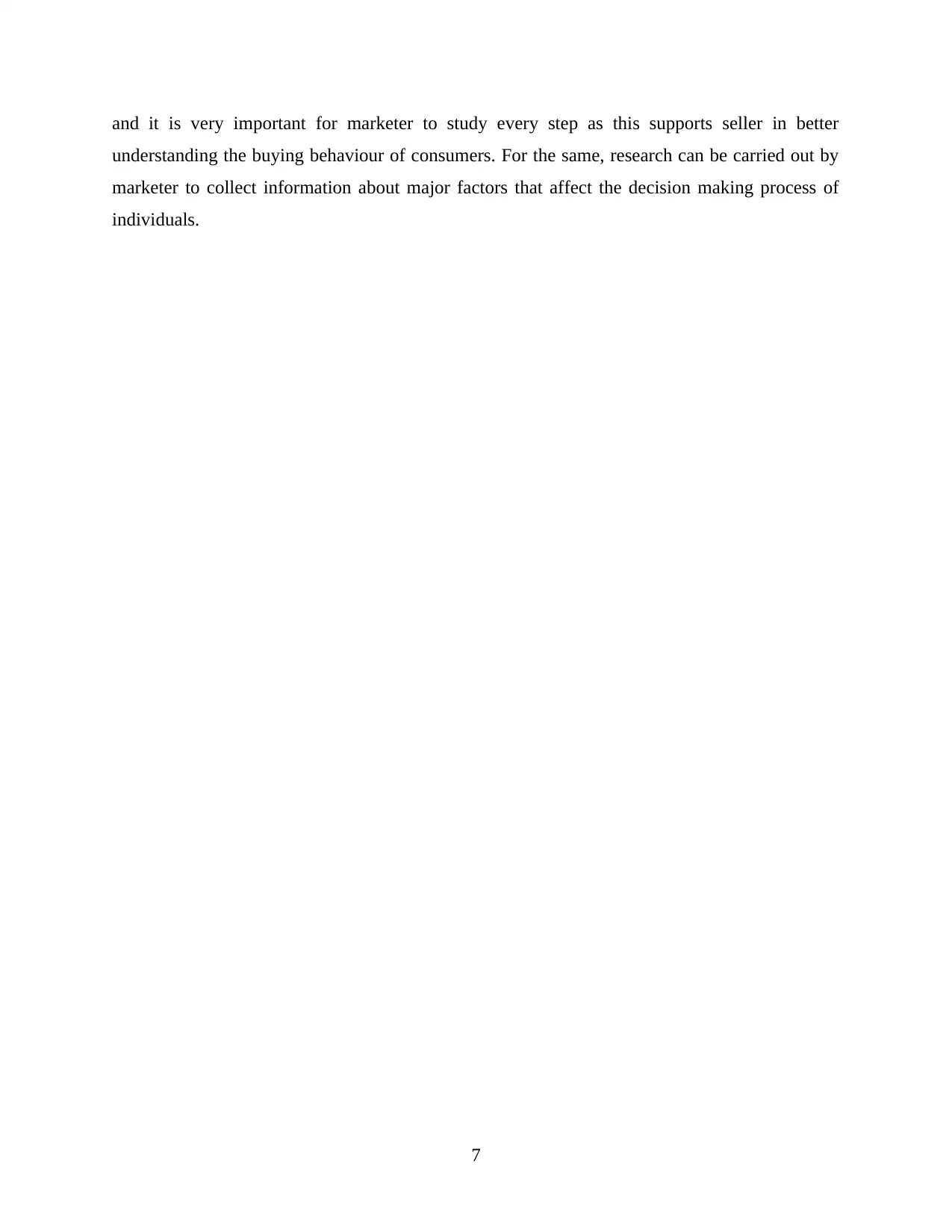
and it is very important for marketer to study every step as this supports seller in better
understanding the buying behaviour of consumers. For the same, research can be carried out by
marketer to collect information about major factors that affect the decision making process of
individuals.
7
understanding the buying behaviour of consumers. For the same, research can be carried out by
marketer to collect information about major factors that affect the decision making process of
individuals.
7
⊘ This is a preview!⊘
Do you want full access?
Subscribe today to unlock all pages.

Trusted by 1+ million students worldwide
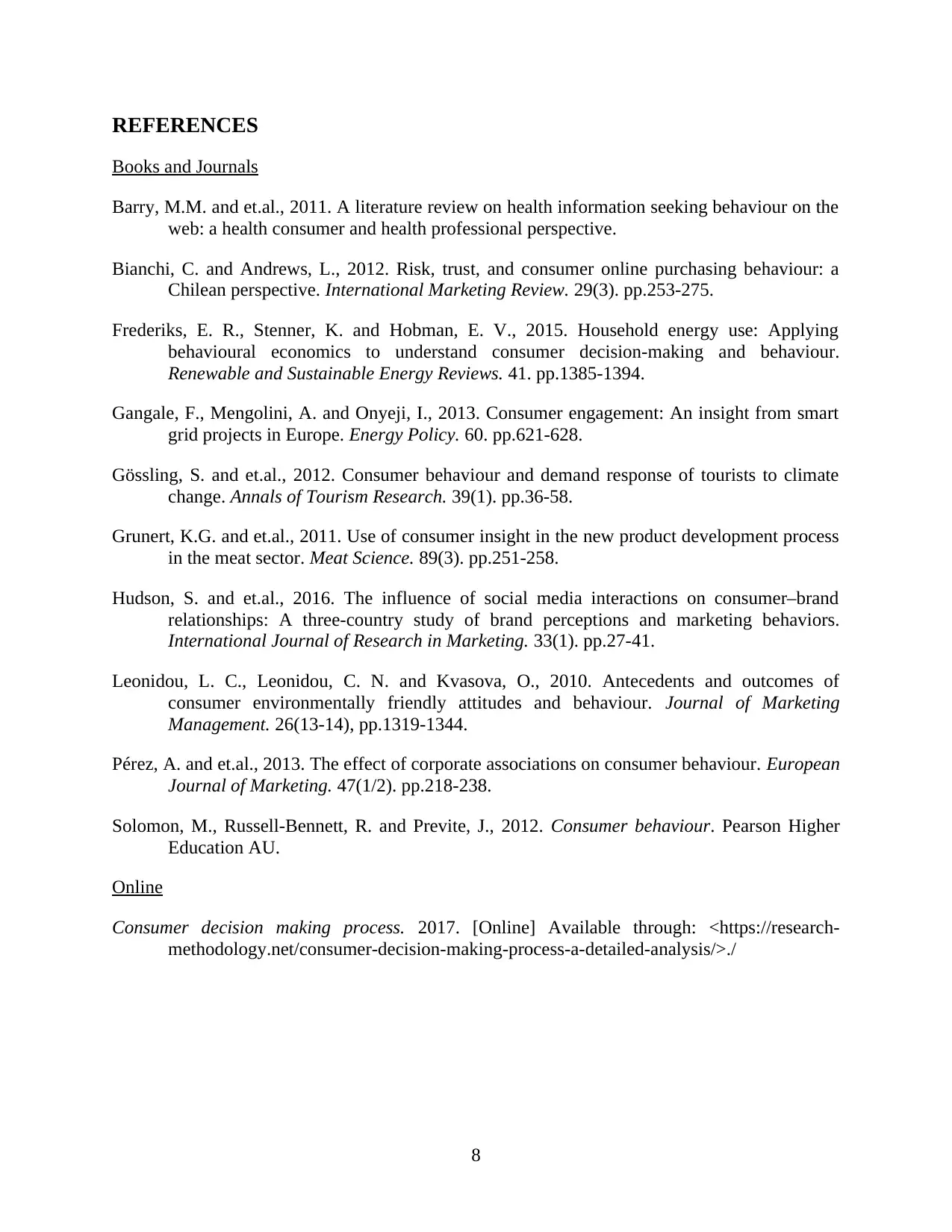
REFERENCES
Books and Journals
Barry, M.M. and et.al., 2011. A literature review on health information seeking behaviour on the
web: a health consumer and health professional perspective.
Bianchi, C. and Andrews, L., 2012. Risk, trust, and consumer online purchasing behaviour: a
Chilean perspective. International Marketing Review. 29(3). pp.253-275.
Frederiks, E. R., Stenner, K. and Hobman, E. V., 2015. Household energy use: Applying
behavioural economics to understand consumer decision-making and behaviour.
Renewable and Sustainable Energy Reviews. 41. pp.1385-1394.
Gangale, F., Mengolini, A. and Onyeji, I., 2013. Consumer engagement: An insight from smart
grid projects in Europe. Energy Policy. 60. pp.621-628.
Gössling, S. and et.al., 2012. Consumer behaviour and demand response of tourists to climate
change. Annals of Tourism Research. 39(1). pp.36-58.
Grunert, K.G. and et.al., 2011. Use of consumer insight in the new product development process
in the meat sector. Meat Science. 89(3). pp.251-258.
Hudson, S. and et.al., 2016. The influence of social media interactions on consumer–brand
relationships: A three-country study of brand perceptions and marketing behaviors.
International Journal of Research in Marketing. 33(1). pp.27-41.
Leonidou, L. C., Leonidou, C. N. and Kvasova, O., 2010. Antecedents and outcomes of
consumer environmentally friendly attitudes and behaviour. Journal of Marketing
Management. 26(13-14), pp.1319-1344.
Pérez, A. and et.al., 2013. The effect of corporate associations on consumer behaviour. European
Journal of Marketing. 47(1/2). pp.218-238.
Solomon, M., Russell-Bennett, R. and Previte, J., 2012. Consumer behaviour. Pearson Higher
Education AU.
Online
Consumer decision making process. 2017. [Online] Available through: <https://research-
methodology.net/consumer-decision-making-process-a-detailed-analysis/>./
8
Books and Journals
Barry, M.M. and et.al., 2011. A literature review on health information seeking behaviour on the
web: a health consumer and health professional perspective.
Bianchi, C. and Andrews, L., 2012. Risk, trust, and consumer online purchasing behaviour: a
Chilean perspective. International Marketing Review. 29(3). pp.253-275.
Frederiks, E. R., Stenner, K. and Hobman, E. V., 2015. Household energy use: Applying
behavioural economics to understand consumer decision-making and behaviour.
Renewable and Sustainable Energy Reviews. 41. pp.1385-1394.
Gangale, F., Mengolini, A. and Onyeji, I., 2013. Consumer engagement: An insight from smart
grid projects in Europe. Energy Policy. 60. pp.621-628.
Gössling, S. and et.al., 2012. Consumer behaviour and demand response of tourists to climate
change. Annals of Tourism Research. 39(1). pp.36-58.
Grunert, K.G. and et.al., 2011. Use of consumer insight in the new product development process
in the meat sector. Meat Science. 89(3). pp.251-258.
Hudson, S. and et.al., 2016. The influence of social media interactions on consumer–brand
relationships: A three-country study of brand perceptions and marketing behaviors.
International Journal of Research in Marketing. 33(1). pp.27-41.
Leonidou, L. C., Leonidou, C. N. and Kvasova, O., 2010. Antecedents and outcomes of
consumer environmentally friendly attitudes and behaviour. Journal of Marketing
Management. 26(13-14), pp.1319-1344.
Pérez, A. and et.al., 2013. The effect of corporate associations on consumer behaviour. European
Journal of Marketing. 47(1/2). pp.218-238.
Solomon, M., Russell-Bennett, R. and Previte, J., 2012. Consumer behaviour. Pearson Higher
Education AU.
Online
Consumer decision making process. 2017. [Online] Available through: <https://research-
methodology.net/consumer-decision-making-process-a-detailed-analysis/>./
8
1 out of 10
Related Documents
Your All-in-One AI-Powered Toolkit for Academic Success.
+13062052269
info@desklib.com
Available 24*7 on WhatsApp / Email
![[object Object]](/_next/static/media/star-bottom.7253800d.svg)
Unlock your academic potential
Copyright © 2020–2025 A2Z Services. All Rights Reserved. Developed and managed by ZUCOL.





